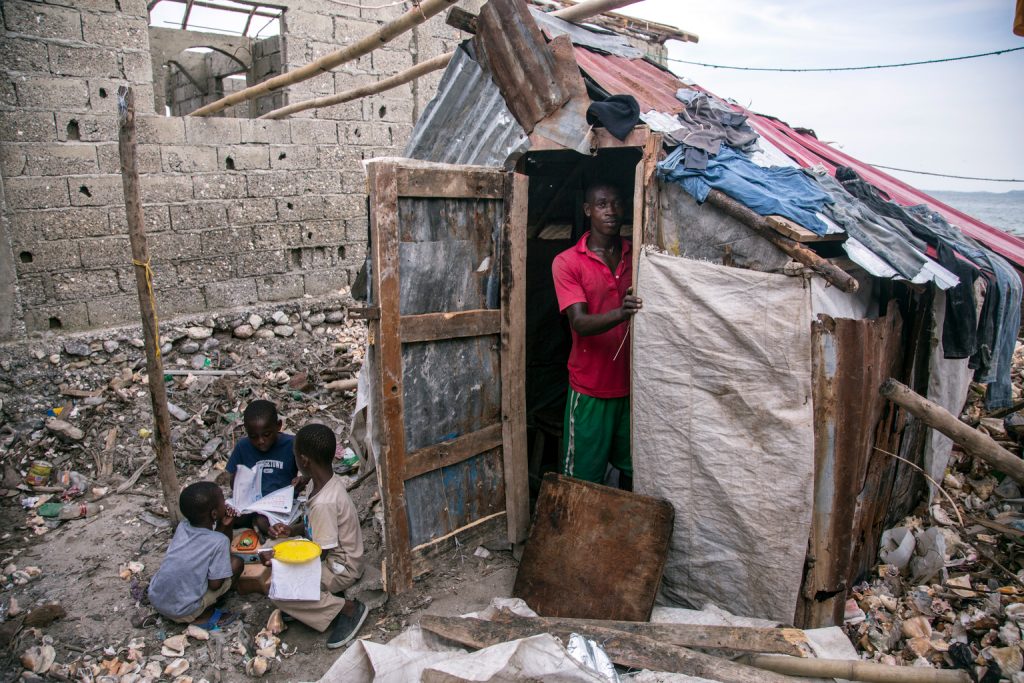This issue of Frontiers of CLTS explores the potential, and some of the recorded learning, on how CLTS, as a community-based, collaborative approach to sanitation behavioural change, can be applied successfully in contexts of fragility and displacement, leading to communities more convinced and prepared to maintain and develop safe sanitation practices.
Evidence Reviews
CLTS in Post-Emergency and Fragile States Settings
Topics
Conflict
UNICEF/UN035979/LeMoyne
On 9 October 0216, a man builds a shack out of the debris of his home while children look through school notebooks they have salvaged in the neighbourhood of La Savane, a poor seaside area of Les Cayes, people sift through the ruins and salvage what they can after the passage of Hurricane Matthew.
Hurricane Matthew passed over Haiti on Tuesday October 4, 2016, with heavy rains and winds. While the capital Port au Prince was mostly spared from the full strength of the class 4 hurricane, the western area of Grand Anse, however was in the direct path. The cities of Les Cayes and Jeremie received the full force sustaining wind and water damage across wide areas. Coastal towns were severely damaged as were many homes in remote mountainous regions. International relief efforts are underway to provide food water and shelter to the people affected by the storm.
Les Cayes is one of the worst affected areas in Grand South with massive flooding in low-lying areas and damage to the townÕs hospital and other health centres. Families are struggling to find safe water and adequate latrines. As of 7 October 2016, up to 80 per cent of homes in the south of Haiti were reportedly damaged with nearly 16,000 people are staying in temporary shelters. As of 10 October 2016, more than 100,000 children are missing out on learning after their schools were either damaged or converted into shelters. A first truck with water-treatment tablets and water bladders arrived in Les Cayes on 6 October 2016 with six more water trucks arriving on 8 October into Les Cayes and Jeremie. In addition, a water bladder was made available for the hospital of Les Cayes and more water storage containers are on their way to the affected areas to be used in shelters housing displaced families. UNICEF had pre-positioned water treatment supplies before the hurricane hit.
Related content
Infographics
Key Considerations: Child Engagement in the Context of Disease Outbreaks in Eastern and Southern Africa
This infographic summarises the insights from a recent key considerations brief on child engagement in the context of disease outbreaks in Eastern and Southern Africa. This brief explores why, when and how to engage children in the prevention, response and…
Central and East Africa Hub
SSHAP
2024
Infographics
Key Considerations for Responding to Floods in South Sudan Through the Humanitarian-Peace-Development Nexus
This infographic summarises the insights from a recent key considerations brief on responding to floods in South Sudan through the lens of Humanitarian-Peace-Development (HDP) Nexus. The brief describes the multidimensional impacts of flooding on peace, health, livelihoods and governance and…
Central and East Africa Hub
SSHAP
2024
Briefing
Key Considerations: Child Engagement in the Context of Disease Outbreaks in Eastern and Southern Africa
Effective child engagement strategies are essential to optimise the response to disease outbreaks and minimise their impact while ensuring children’s protection, well-being and resilience. When children understand disease outbreaks, they are better able to cope, contribute and recover. This promotes…
Central and East Africa Hub
SSHAP
2024
Briefing
Key Considerations for Responding to Floods in South Sudan Through the Humanitarian-Peace-Development Nexus
In common with many other African countries, the Republic of South Sudan is increasingly experiencing devastating floods linked to climate change.1,2 The Indian Ocean Dipole (IOD) and El Niño regulate the climate of Equatorial Eastern Africa. In 2019, a dipole…
Central and East Africa Hub
SSHAP
2024


